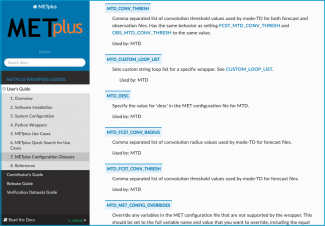The idea of including the enhanced Model Evaluation Tools (METplus) in NOAA operations for the verification and validation of Environmental Modeling Center (EMC)’s suite of environmental prediction models has been a decade in the making. METplus is the DTC-developed verification framework that spans a wide range of temporal (warn-on-forecast to climate) and spatial (storm to global) scales. It is intended to be extensible through additional capability developed by the community and the transition of this framework to NOAA’s Weather and Climate Operational Supercomputing System (WCOSS) was a major accomplishment. This partnership project between DTC, NOAA’s EMC, and the National Centers for Environmental Prediction (NCEP) Central Operations (NCO) is an on-going engagement. Through its development, METplus has become an integral part in the verification work of NOAA’s modeling operations because of the robust software, suite of capabilities, ease of use and documentation, and the fact that METplus is continually evolving. METplus has made the desire to have reliable, consistent statistical output a reality and will help bolster the next generation of numerical models to higher forecast prediction accuracy. As a result of this hand-in-hand partnership and cooperation to build and test the latest versions of METplus, less time is needed by numerical weather prediction (NWP) model developers to assess how a NWP model can be improved. METplus has the statistical and graphical verification output they need to diagnose shortcomings efficiently and optimize NWP settings for the next generation of NWP models. METplus’ output has been tested against real-time datasets from NOAA and compared to in-house calculations for precision and ease of use.
DTC, EMC, and NCO worked collaboratively and iteratively to install METplus-3.1 and MET-9.1 on the WCOSS developmental system to test and optimize the software between August 2020 and March 2021, with the goal of installing the METplus system into real-time operations once WCOSS2 is available to EMC scientists. METplus-4.0.0 is planned to be the foundation of the burgeoning EMC Verification System (EVS).
In April 2021, the software was officially installed into 24/7 operations at NCO on WCOSS (soon to be WCOSS2). This milestone will now allow EMC to run operational METplus verification tasks and continue to build METplus into real-time Unified Forecast System (UFS) applications. This represents a major achievement in the UFS Research to Operations to Research (R2O2R) paradigm, as verification metrics developed within the UFS community now have a direct pathway to operations.
One part of the change METplus brings as an operational companion to numerical weather forecasting is in its support and documentation. METplus is fully supported: METplus has a User’s Guide for each of its components (with additional information available on the METplus Website). The documentation is continuously updated and refined as needed for operability and understanding. Configuration options and keywords can be easily searched in each guide, eliminating the need to bookmark a specific page for reference. With community support through a GitHub Discussions board, all documented user issues in METplus will receive the direct attention of the METplus scientists,engineers, and the METplus community at large. If an opportunity for enhancing METplus is brought forward from these help sources, a METplus team member will create a Github issue, allowing users to track the progress.
METplus is not only a component of NOAA's Unified Forecast System (UFS) cross-cutting infrastructure but will also be an evaluation and diagnostic capability for NCAR's System for Integrated Modeling of the Atmosphere (SIMA). METplus is actively being developed by NCAR/Research Applications Laboratory (RAL), NOAA Global Systems Laboratory (GSL), EMC, several US Department of Defense agencies and departments, and the Unified Modeling partners led by the Met Office of the United Kingdom. Finally, METplus is a community resource via the DTC and is open for community contributions to the transition of successful ideas from research to operations.

